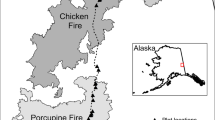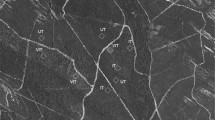Abstract
Pinus halepensis forests are among the forest ecosystems in the Mediterranean Basin most affected by fire. Their distribution across lowland areas, in particular along the wildland–urban interface, increases the need to understand their ecology and responses to fire regime for their effective management. Apart from the extremely flammable tree layer, in several stands of these forests there is an increased fuel load attributed to the well-developed understorey of evergreen sclerophyllous shrubs. Taking into consideration that, in contrast with the long period required for full development of post-fire-regenerating pines, these shrubs resprout vigorously within the first post-fire weeks, it is important to explore the temporal trend of fuel accumulation to determine the risk of a second fire across a burned landscape. Two post-fire chronosequences of, in total, 12 P. halepensis stands were considered for sampling in Central Greece. The first chronosequence corresponds to pine stands characterized by the dominance of evergreen sclerophyllous shrubs in the understorey (Type 1) whereas the second chronosequence corresponds to pine stands where the cover of such shrubs was lower (Type 2). This study helps in understanding the fuel dynamics according to the type of P. halepensis forest stand and to anticipate future biomass growth. The proposed equations are simple tools, enabling land managers to estimate understorey total fuel load easily by visually recording the cover and height of the evergreen sclerophyllous shrub component, to justify understorey fuel reduction measures.


Similar content being viewed by others
References
Arianoutsou M (1984) Post-fire successional recovery of a phryganic (East Mediterranean) ecosystem. (Acta Oecol) Oecol Plant 5:387–394
Arianoutsou M (2001) Landscape changes in Mediterranean ecosystems of Greece: implications for fire and biodiversity issues. J Mediterr Ecol 2:165–178
Baeza MJ, Raventos J, Escarre A, Vallejo VR (2006) Fire risk and vegetation structural dynamics in Mediterranean shrubland. Plant Ecol 187:189–201
Burgan RE, Rothermel RC (1984) BEHAVE: fire behavior prediction and fuel modeling system. FUEL subsystem. USDA Forest Service General Technical Report INT 167
Clemente AS, Rego FC, Correia OA (1996) Demographic patterns and productivity of post-fire regeneration in Portuguese Mediterranean maquis. Int J Wildl Fire 6:5–12
Guo Q (2001) Early post-fire succession in California chaparral: changes in diversity, density, cover and biomass. Ecol Res 16:471–485
Hatzistathis A, Zagas Th, Gkanatsas P, Tsitsoni Th (1999) Experimental work on restoration techniques after wildfires in forest ecosystems in Chalkidiki, North Greece. In: Proceedings of the international symposium on “forest fires: needs and innovations”, Athens, Greece, 18–19 November 1999. CINAR S.A., pp 310–315
Hough WA, Albini FA (1978) Predicting fire behavior in palmetto–gallberry fuel complexes. USDA Forest Service Research Paper SE-184
Kazanis D (2005) Post-fire succession in Pinus halepensis forests of Greece: patterns of vegetation dynamics. PhD thesis, University of Athens (in Greek with an English summary)
Kazanis D, Arianoutsou M (2004) Long-term post-fire vegetation dynamics in Pinus halepensis forests of Central Greece: a functional group approach. Plant Ecol 171:101–121
Mitsopoulos ID, Dimitrakopoulos AP (2007) Allometric equations for crown fuel biomass of Aleppo pine (Pinus halepensis Mill.) in Greece. Int J Wildl Fire 16:642–647
Montes N, Ballini C, Bonin G, Faures J (2004) A comparative study of aboveground biomass of three Mediterranean species in a post-fire succession. Acta Oecol 25:1–6
Pausas JG, Keeley JE (2009) A burning story: the role of fire in the history of life. Bioscience 59:593–601
Quezel P, Barbero M (1992) Le pin d’Alep et les espèces voisines: répartition et caractères écologiques généraux, sa dynamique récente en France méditerranéenne. Forêt Méditer 13:158–170
Raison J (2005) Changes in flammability of vegetation in relation to fire frequency: fuel dynamics after prescribed fire and wildfire in forests of ACT. Final report on research project funded by the Australian Flora Foundation. (http://www.aff.org.au/Raison_flammability_final.pdf )
Xanthopoulos G, Manasi M (2002) A practical methodology for the development of shrub fuel models for fire behavior prediction. In: Viegas DX (ed) Proceedings of the 4th international conference on forest fire research, Luso-Coimbra, Portugal. Millpress, The Netherlands (electronic edition)
Acknowledgments
This paper is based on data collected for the Ph.D. dissertation of the first author. His work was extended, leading to the current publication, in the framework of the EUFIRELAB research project, funded by the European Commission, DG Research, 5th Framework Programme (Contract EVR1-CT-2002-40028). Mrs Penny Marinou (Litterae®) edited the manuscript.
Author information
Authors and Affiliations
Corresponding author
About this article
Cite this article
Kazanis, D., Xanthopoulos, G. & Arianoutsou, M. Understorey fuel load estimation along two post-fire chronosequences of Pinus halepensis Mill. forests in Central Greece. J For Res 17, 105–109 (2012). https://doi.org/10.1007/s10310-011-0250-0
Received:
Accepted:
Published:
Issue Date:
DOI: https://doi.org/10.1007/s10310-011-0250-0




